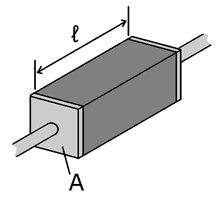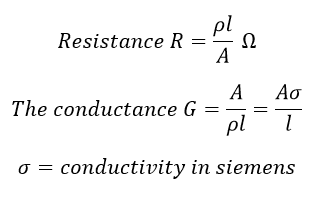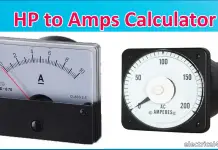What is Conductance:
Conductance and Resistance are opponent phenomena. When a substance or material can conduct better, we say that its resistance is less. When it conducts less, we say that its resistance is high. But most of the time electrical engineers don’t mention resistance or a material rather they prefer to speak about conductance of a material.

[wp_ad_camp_1]
The reciprocal of resistance is called conductance.
Conductance is the ability of a substance or material to pass electricity. The measure of the opposite of resistance is conductance. Siemens, S is the unit of conductance. When the resistance of a component is 1 ohm then its conductance is also 1 Siemens. When the resistance is increased to double, the conductance is decreased to half and vice-versa.
The relation between Siemens and ohms can be written as:
Siemens = 1/ohms, or
ohms =1/Siemens
Resistivity Vs Conductivity of The Material |
||
| Material | ρ (Ω·m) at 20 °C | σ (S/m) at 20 °C |
| Silver | 1.59×10−8 | 6.30×107 |
| Copper | 1.68×10−8 | 5.96×107 |
| Annealed copper | 1.72×10−8 | 5.80×107 |
| Gold | 2.44×10−8 | 4.10×107 |
| Aluminium | 2.65×10−8 | 3.77×107 |
| Calcium | 3.36×10−8 | 2.98×107 |
| Tungsten | 5.60×10−8 | 1.79×107 |
| Zinc | 5.90×10−8 | 1.69×107 |
| Nickel | 6.99×10−8 | 1.43×107 |
| Lithium | 9.28×10−8 | 1.08×107 |
| Iron | 9.71×10−8 | 1.00×107 |
| Platinum | 1.06×10−7 | 9.43×106 |
| Tin | 1.09×10−7 | 9.17×106 |
| Gallium | 1.40×10−7 | 7.10×106 |
| Carbon steel (1010) | 1.43×10−7 | 6.99×106 |
| Lead | 2.20×10−7 | 4.55×106 |
| Titanium | 4.20×10−7 | 2.38×106 |
| Grain oriented electrical steel | 4.60×10−7 | 2.17×106 |
| Manganin | 4.82×10−7 | 2.07×106 |
| Constantan | 4.90×10−7 | 2.04×106 |
| Stainless steel | 6.90×10−7 | 1.45×106 |
| Mercury | 9.80×10−7 | 1.02×106 |
| Nichrome | 1.10×10−6 | 6.7×105 |
| GaAs | 1.00×10−3 to 1.00×108 | 1.00×10−8 to 103 |
| Carbon (amorphous) | 5.00×10−4 to 8.00×10−4 | 1.25×103 to 2×103 |
| Carbon (graphite) | 2.50×10−6 to 5.00×10−6 ∥basal plane | 2.00×105 to 3.00×105 ∥basal plane |
| 3.00×10−3 ⊥basal plane | 3.30×102 ⊥basal plane | |
| Germanium | 4.60×10−1 | 2.17 |
| Seawater | 2.00×10−1 | 4.8 |
| Swimming pool water | 3.33×10−1 to 4.00×10−1 | 0.25 to 0.30 |
| Drinking water | 2.00×101 to 2.00×103 | 5.00×10−4 to 5.00×10−2 |
| Silicon | 6.40×102 | 1.56×10−3 |
| Wood (damp) | 1.00×103 to 1.00×104 | 10−4 to 10−3 |
| Deionized water | 1.80×105 | 5.50×10−6 |
| Glass | 1.00×1011 to 1.00×1015 | 10−15 to 10−11 |
| Hard rubber | 1.00×1013 | 10−14 |
| Wood (oven dry) | 1.00×1014 to 1.00×1016 | 10−16 to 10−14 |
| Sulfur | 1.00×1015 | 10−16 |
| Air | 1.30×1014 to 3.30×1014 | 3×10−15 to 8×10−15 |
| Carbon (diamond) | 1.00×1012 | ~10−13 |
| Fused quartz | 7.50×1017 | 1.30×10−18 |
| PET | 1.00×1021 | 10−21 |
| Teflon | 1.00×1023 to 1.00×1025 | 10−25 to 10−23 |













![What is Arc Chute? Types, Working Principle [Video Included] arc chute working priciple](https://www.electrical4u.net/wp-content/uploads/2020/06/arc-chute-218x150.png)